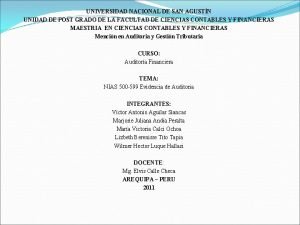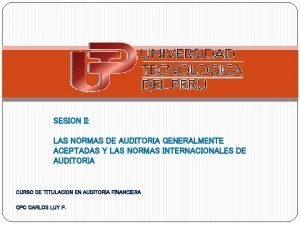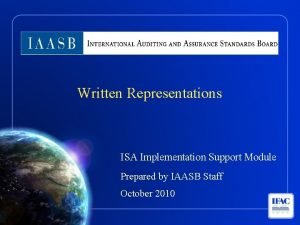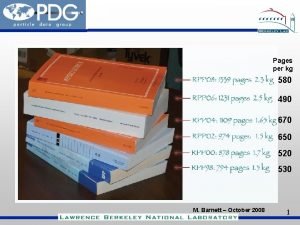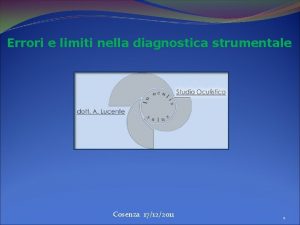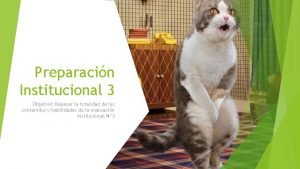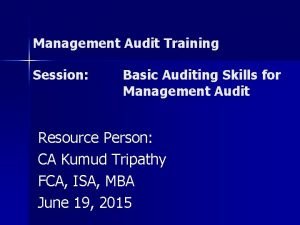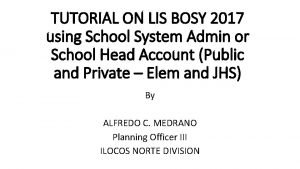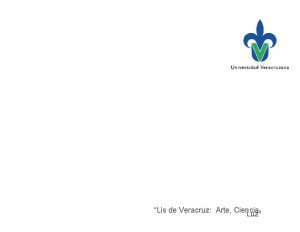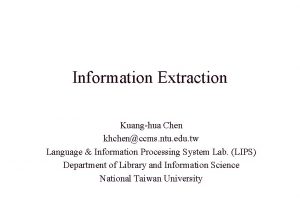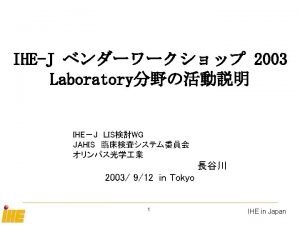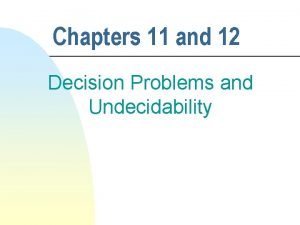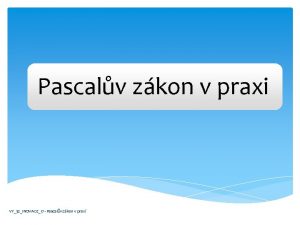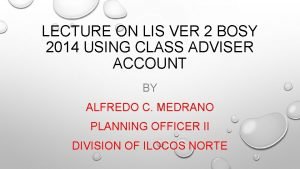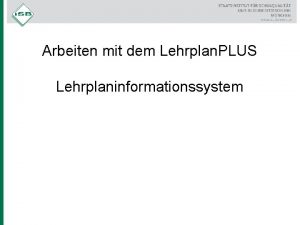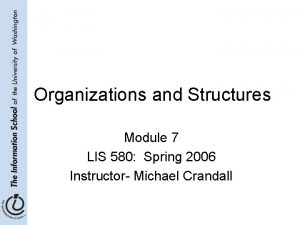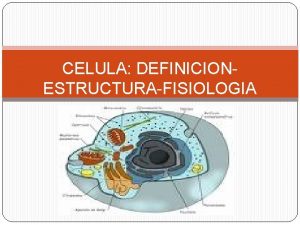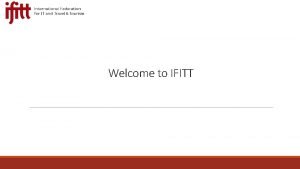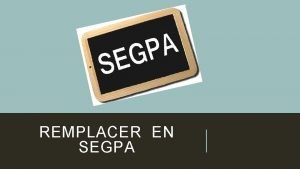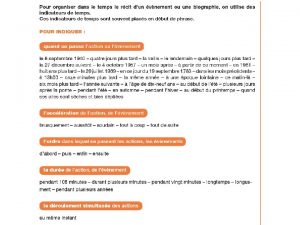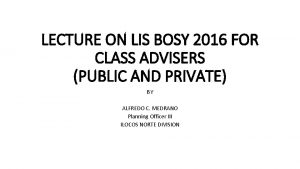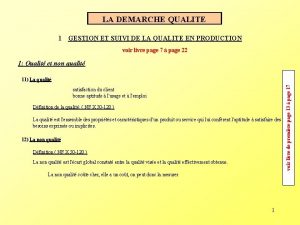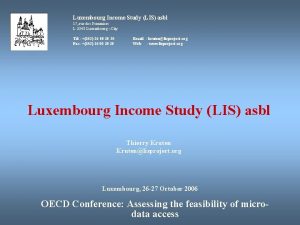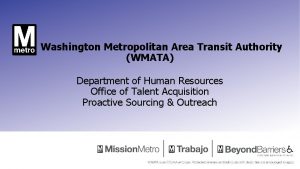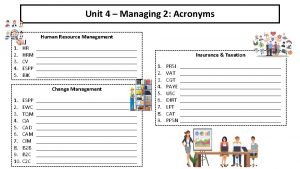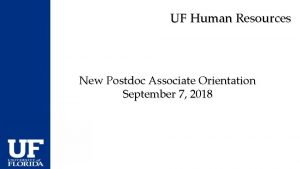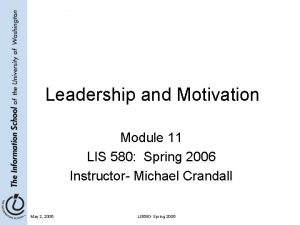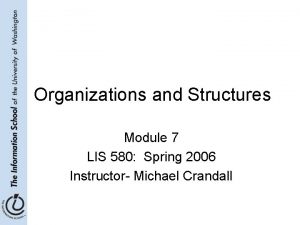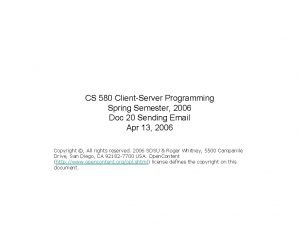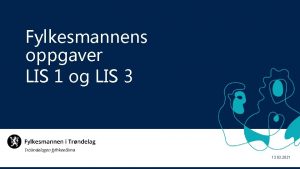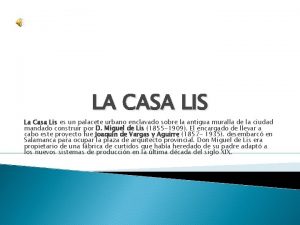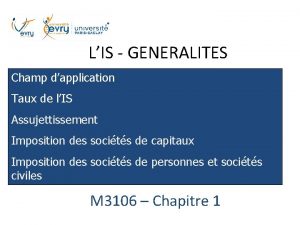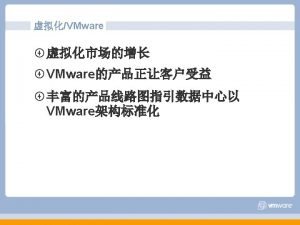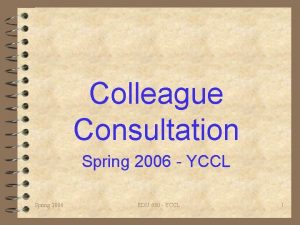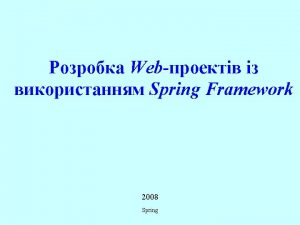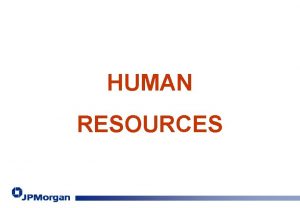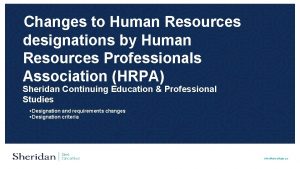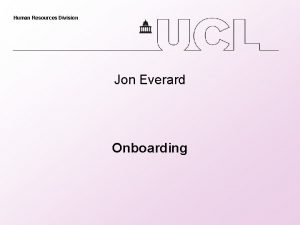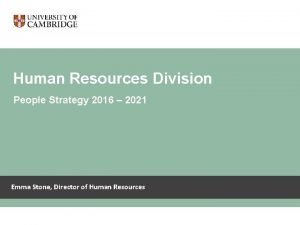Human Resources Module 8 LIS 580 Spring 2006











































- Slides: 43

Human Resources Module 8 LIS 580: Spring 2006 Instructor- Michael Crandall

Roadmap • • The Human Resources environment The Human Resources management process Recruiting Interviewing Training Disciplining Legal and ethical concerns April 20, 2006 LIS 580 - Spring 2006 2

Human Resources (HR) Management • Human Resources (HR) Management – The management function devoted to acquiring, training, appraising, and compensating employees. • Strategic Human Resource Management – The linking of the human resource function with the company’s strategies to accomplish that strategy. G. Dessler, 2003 April 20, 2006 LIS 580 - Spring 2006 3

Work. USA 2002 & Malden Mills • Work. USA 2002 study showed: – Trust levels dropping within organizations – HR functions emphasizing effectiveness of employees key to increased trust. – Less than half of employees say businesses manage changes well. – Communication is miserable, especially related to pay. – Employees don’t get linkage between corporate strategy and their jobs. – Linkage of performance rewards to business goals is not effective. • How is Malden Mills different? April 20, 2006 LIS 580 - Spring 2006 4

The Human Resources Management Environment Prentice Hall, 2002 April 20, 2006 LIS 580 - Spring 2006 5

The Basic HR Process FIGURE 9– 1 G. Dessler, 2003 April 20, 2006 LIS 580 - Spring 2006 6

Personnel Planning • • The process by which management ensures it has the right number and kinds of people in the right places at the right time, who are capable of helping the organization achieve its goals Steps in the planning process: 1. Assessing current human resources 2. Assessing future human resources needs and developing a program to meet those needs Prentice Hall, 2002 April 20, 2006 LIS 580 - Spring 2006 7

Steps in the Recruitment and Selection (staffing) Process FIGURE 9– 2 G. Dessler, 2003 April 20, 2006 LIS 580 - Spring 2006 8

Management Personnel Replacement Chart

Writing Job Descriptions And Recruiting Employees • Staffing – Filling a firm’s open positions; also, the personnel process that includes six steps: • • • job analysis personnel planning recruiting interviewing testing and selection training and development G. Dessler, 2003 April 20, 2006 LIS 580 - Spring 2006 10

Job Analysis • Job Analysis – The procedure used to determine the duties of particular jobs and the kinds of people (in terms of skills and experience) who should be hired for them. • Job Specification – The human qualifications in terms of traits, skills, and experiences required to accomplish a job. • Job Description – A document that identifies a particular job, provides a brief job summary, and lists specific responsibilities and duties of the job. G. Dessler, 2003 April 20, 2006 LIS 580 - Spring 2006 11

Checklist 9. 1 Job Analysis Questions þ What is the job being performed? þ What are the major duties of your position? What exactly do you do? þ What are the education, experience, skill, and [where applicable] certification and licensing requirements? þ In what activities do you participate now? þ What are the job’s responsibilities and duties? þ What are the basic accountabilities or performance standards that typify your work? G. Dessler, 2003 April 20, 2006 LIS 580 - Spring 2006 12

Checklist 9. 1 (cont’d) Job Analysis Questions þ What are your responsibilities? þ What are the environmental and working conditions involved? þ What are the job’s physical demands? Its emotional and mental demands? þ What are the health and safety conditions? þ Does the job expose you to any hazards or unusual working conditions? G. Dessler, 2003 April 20, 2006 LIS 580 - Spring 2006 13

Employee Recruiting • Recruiting – Attracting a pool of viable job applicants. G. Dessler, 2003 April 20, 2006 LIS 580 - Spring 2006 14

Sources of Recruits • • Current employees Advertising The Internet Employment agencies • College recruiting • Recruiting for a diverse workforce – Public – Private • Contingent workers and temporary help agencies • Executive recruiters • Employee referrals • Walk-ins G. Dessler, 2003 April 20, 2006 LIS 580 - Spring 2006 15

Testing for Employee Selection • Uses of Tests – Reliability (repeatability of test results) – Validity (measures what it purports to measure) • Types of Tests – – Intelligence Mechanical comprehension Personality and interests Ability/achievement (current capabilities/knowledge) – Aptitude (performance potential) – Management assessment center G. Dessler, 2003 April 20, 2006 LIS 580 - Spring 2006 16

Conducting Effective Interviews • • • Plan the interview Structure the interview Establish rapport Ask effective questions Delay your decision Close the interview G. Dessler, 2003 April 20, 2006 LIS 580 - Spring 2006 17

Guidelines for Interviewees • • Prepare Make a good first impression Uncover the interviewer’s needs Relate your answers to the interviewer’s needs • Think before answering • Watch your nonverbal behavior G. Dessler, 2003 April 20, 2006 LIS 580 - Spring 2006 18

Potential Biases in Interviews • Prior knowledge about the applicant will bias the interviewer’s evaluation • The interviewer tends to hold a stereotype of what represents a good applicant • The interviewer tends to favor applicants who share his or her own attitudes • The order in which applicants are interviewed will influence evaluations • The order in which information is elicited during the interview will influence evaluations Prentice Hall, 2002 April 20, 2006 LIS 580 - Spring 2006 19

Potential Biases in Interviews (cont’d) • Negative information is given unduly high weight • The interviewer may make a decision concerning the applicant’s suitability within the first four or five minutes of the interview • The interviewer may forget much of the interview’s content within minutes after its conclusion • The interview is most valid in determining an applicant’s intelligence, level of motivation, and interpersonal skills • Structured and well-organized interviews are more reliable than unstructured and unorganized ones Prentice Hall, 2002 April 20, 2006 LIS 580 - Spring 2006 20

Orienting Employees • Orientation – The introduction of a new employee to the job and the organization • Objectives of orientation – To reduce the initial anxiety all new employees feel as they begin a new job – To familiarize new employees with the job, the work unit, and the organization as a whole – To facilitate the outsider–insider transition April 20, 2006 LIS 580 - Spring 2006 21

Training Employees • Training Program – The process of providing new employees with information they need to do their jobs satisfactorily. • Training Program Steps – Needs analysis – Instructional design – Validation – Implementation – Evaluation and follow-up G. Dessler, 2003 April 20, 2006 LIS 580 - Spring 2006 22

Employee Training • What and Why? – Changing skills, knowledge, attitudes, or behavior. – Changing what employees know, how they work; or their attitudes toward their jobs, co-workers, managers, and the organization • On-the-Job Training Methods – Job rotation – Understudy assignments • Off-the-Job Training Methods – – Classroom lectures Films and videos Simulation exercises Vestibule training Prentice Hall, 2002 April 20, 2006 LIS 580 - Spring 2006 23

Determining if Training Is Needed Prentice Hall, 2002 April 20, 2006 LIS 580 - Spring 2006 24

Performance Management and Measurement • Performance management system – A process of establishing performance standards and evaluating performance in order to arrive at objective human resource decisions and to provide documentation to support personnel actions • Adjective rating scales – Rating an individual on each job performance factor on an incremental scale • 360 -degree appraisal – An appraisal device that seeks feedback from a variety of sources for the person being rated Prentice Hall, 2002 April 20, 2006 LIS 580 - Spring 2006 25

Performance Management and Measurement (cont. ) • Group-order ranking – Requires the evaluator to place employees into a particular classification such as “top fifth” or “second fifth” • Individual ranking approach – Requires the evaluator merely to list the employees in order from highest to lowest • Paired comparison approach – Each employee is compared with every other employee in the comparison group and rated as either the superior or weaker member of the pair – Each employee is assigned a summary ranking based on the number of superior scores achieved • MBO – Employees are evaluated by how well they accomplish a specific set of objectives determined to be critical in the successful completion of their jobs Prentice Hall, 2002 April 20, 2006 LIS 580 - Spring 2006 26

Performance Appraisal Form Source: Gary Dessler, Human Resource Management, 9 th ed. (Upper Saddle River, NJ: Prentice. Hall, 2000), p. 90. FIGURE 9– 13

Checklist 9. 5 How to Conduct the Appraisal Interview þ Prepare for the interview. þ Be direct and specific. þ Don’t get personal. þ Encourage the person to talk. þ Don’t tiptoe around. G. Dessler, 2003 April 20, 2006 LIS 580 - Spring 2006 28

When Performance Falls Short • Performance impediments – Mismatched skills – Inadequate training – Employee’s personal problems • Discipline – Actions taken by a manager to enforce an organization’s standards and regulations • Employee counseling – A process designed to help employees overcome performance-related problems Prentice Hall, 2002 April 20, 2006 LIS 580 - Spring 2006 29

Jack Stack and Scott Berkun • What does Stack point out about the problems with most performance reviews? • How does he use his reviews to help his staff improve performance? • Stack is a CEO, reviewing high-level directors. How do you think his approach would work at lower levels of the organization? • He doesn’t file any paperwork or other documentation. Do you see any issues with this in the long term? • What does Berkun see as the main job of a manager? • How does Berkun’s advice compare with Stack’s approach? April 20, 2006 LIS 580 - Spring 2006 30

Compensation And Benefits • Compensation administration – Determining a cost-effective pay structure that will attract and retain competent employees, provide an incentive for them to work hard, and ensure that pay levels will be perceived as fair • Factors influencing pay levels – – – Employee’s job Kind of business Environment surrounding the job Geographic location Employee performance levels and seniority Prentice Hall, 2002 April 20, 2006 LIS 580 - Spring 2006 31

Types of Employee Benefits • Social Security • Workers’ and unemployment compensations • Paid time off from work • Life and disability insurance • Retirement programs • Health insurance • Non-financial rewards designed to enrich employees’ lives Prentice Hall, 2002 April 20, 2006 LIS 580 - Spring 2006 32

Discipline and Grievances • FRACT Model – A multi-step procedure for assessing the need for discipline: • • • Get the Facts Find the Reason Audit the records Pinpoint Consequences Identify the Type of infraction. G. Dessler, 2003 April 20, 2006 LIS 580 - Spring 2006 33

Discipline and Grievances (cont’d) • Discipline without Punishment – A multistage disciplinary technique that uses oral reminders of the violated rule; then written reminders; followed by a paid one-day leave; and finally, if the behavior is not corrected, dismissal. • Grievance – A complaint that an employee lodges against an employer, usually one regarding wages, hours, or some condition of employment, such as unfair supervisory behavior. G. Dessler, 2003 April 20, 2006 LIS 580 - Spring 2006 34

Checklist 9. 6 Guidelines for Disciplining an Employee þ Make sure the evidence supports the charge. þ Protect the employee’s due process rights. þ Warn the employee of the disciplinary consequences. þ The rule allegedly violated should be “reasonably related” to the efficient and safe operation of the work environment. þ Fairly and adequately investigate the matter. þ Be sure there is substantial evidence of misconduct. G. Dessler, 2003 April 20, 2006 LIS 580 - Spring 2006 35

Checklist 9. 6 (cont’d) Guidelines for Disciplining an Employee þ Apply rules, orders, or penalties even-handedly. þ Make sure the penalty is reasonably related to the misconduct and to the employee’s past work history. þ Maintain the employee’s right to counsel. þ Don’t rob your subordinate of his or her dignity. þ Remember that the burden of proof is on you. þ Get the facts. Don’t base your decision on hearsay or “general impression. ” þ Don’t act while angry. G. Dessler, 2003 April 20, 2006 LIS 580 - Spring 2006 36

Summary of Important Equal Employment Opportunity Legislation • Title VII of 1964 Civil Rights Act, as amended • Executive orders • Federal agency guidelines • Supreme court decisions: – Griggs v. Duke Power Co. , Albemarle v. Moody • Equal Pay Act of 1967 • Age Discrimination in Employment Act of 1967 • State and local laws • Vocational Rehabilitation Act of 1973 Source: Gary Dessler, Human Resource Management, 7 th ed. (Upper Saddle River, NJ: Prentice-Hall, 2000), p. 52. April 20, 2006 LIS 580 - Spring 2006 • Pregnancy Discrimination Act of 1978 • Vietnam Era Veteran’s Readjustment Assistance Act of 1974 • Wards Cove v. Antonio; Patterson v. Mc. Lean Credit Union • Morton v. Wilks • Americans with Disabilities Act of 1990 • Civil Rights Act of 1991 G. Dessler, 2003 37

Affirmative Action • Affirmative Action – A legislated requirement that employers make an extra effort to hire and promote those in a protected (women or minority) group. G. Dessler, 2003 April 20, 2006 LIS 580 - Spring 2006 38

Improving Workforce Diversity • Widen the recruiting net to broaden the pool of applicants • Ensure the selection process is nondiscriminatory • Assist new employees in assimilating into the firm’s culture • Conduct specialized orientations and workshops for new employees Prentice Hall, 2002 April 20, 2006 LIS 580 - Spring 2006 39

Diversity as Policy • What do these statistics point out about the current state of diversity in our organizations? • Have you seen evidence of this in your own work? • Why is marketing seen as so important in encouraging diversity? Do you agree? April 20, 2006 LIS 580 - Spring 2006 40

Labor–Management Relations • Norris–La. Guardia Act – Guarantees each employee the right to bargain with employers for union benefits. • Wagner Act – Outlaws unfair labor practices such as employers interfering with, restraining, or coercing employees who are exercising their legally sanctioned rights of organizing themselves into a union. • The Taft–Hartley Act – Prohibits unfair labor practices by unions against employers (like refusing to bargain with the employer). • The Landrum-Griffin Act – Protects union members from unfair practices perpetrated against them by their unions. G. Dessler, 2003 April 20, 2006 LIS 580 - Spring 2006 41

Layoffs and Downsizing • Layoff-survivor sickness – The set of attitudes, perceptions, and behaviors of employees who remain after involuntary staff reductions • Dealing with the “Survivor Syndrome” – Provide opportunities for employees to talk to counselors about their guilt, anger, and anxiety – Provide group discussions for the survivors to vent their feelings – Implement employee participation programs such as empowerment and self-managed work teams Prentice Hall, 2002 April 20, 2006 LIS 580 - Spring 2006 42

Next Time • Guest Lecturer: Cara Wilson from Teams and Leaders – We’ll be looking at some practical cases of organizational dynamics, and some techniques consultants use to examine and change them – Read the assigned article for some ideas for questions, and bring your own from the past week’s readings and discussions April 20, 2006 LIS 580 - Spring 2006 43
 Nia 530 ejemplos prácticos
Nia 530 ejemplos prácticos Nia 610
Nia 610 Isa 580 written representations summary
Isa 580 written representations summary Sterling elite 580
Sterling elite 580 Diketahui sin 580°
Diketahui sin 580° 580-490
580-490 Pachimetria 580
Pachimetria 580 El matematico griego pitagoras nacio en el año 580
El matematico griego pitagoras nacio en el año 580 Nsa 580
Nsa 580 Cast of spring, summer, fall, winter... and spring
Cast of spring, summer, fall, winter... and spring What are the months of fall
What are the months of fall Operations transformation process
Operations transformation process Fixed resources definition
Fixed resources definition Renewable vs nonrenewable resources worksheet
Renewable vs nonrenewable resources worksheet C device module module 1
C device module module 1 How to remove personnel in lis
How to remove personnel in lis Lis de veracruz arte ciencia luz
Lis de veracruz arte ciencia luz Je lis des syllabes
Je lis des syllabes Křivka lis
Křivka lis Lis de veracruz
Lis de veracruz La lengua de la mariposa
La lengua de la mariposa Ntu lis
Ntu lis Hospital adt system
Hospital adt system Land-l are recursive enumerable then lis
Land-l are recursive enumerable then lis Hydraulický lis výpočet
Hydraulický lis výpočet Search lrn of students
Search lrn of students Lis bosy
Lis bosy Lis ampath
Lis ampath Lehrplaninformationssystem
Lehrplaninformationssystem Lis lewis structure
Lis lewis structure Slide hệ thống thông tin logistics
Slide hệ thống thông tin logistics Celula hepatocito
Celula hepatocito Lis tussyadiah
Lis tussyadiah Whats lis pendens
Whats lis pendens Remplacer en segpa
Remplacer en segpa Lis et observe les constructions en gras
Lis et observe les constructions en gras Lis deped ph enrolment masterlist
Lis deped ph enrolment masterlist Capabilité machine exemple
Capabilité machine exemple Kruk i lis tekst
Kruk i lis tekst Lis luxembourg
Lis luxembourg Lis.rlp
Lis.rlp Wmata human resources
Wmata human resources Human resources acronyms
Human resources acronyms Human resources uf
Human resources uf
